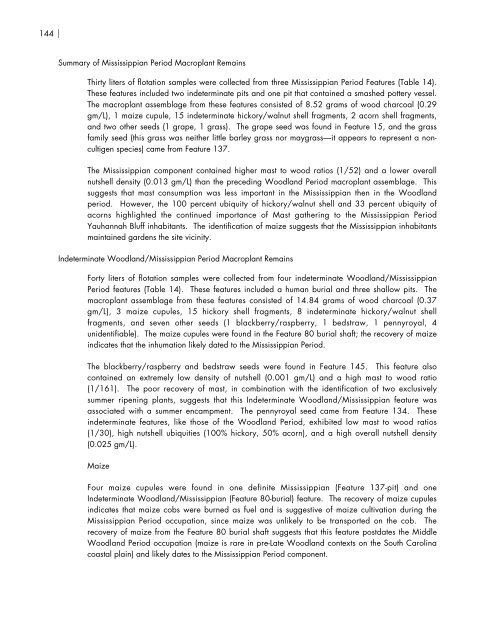Archaeological Investigations at Yourhaney Plantation (38GE18)
Archaeological Investigations at Yourhaney Plantation (38GE18)
Archaeological Investigations at Yourhaney Plantation (38GE18)
Create successful ePaper yourself
Turn your PDF publications into a flip-book with our unique Google optimized e-Paper software.
144Summary of Mississippian Period Macroplant RemainsThirty liters of flot<strong>at</strong>ion samples were collected from three Mississippian Period Fe<strong>at</strong>ures (Table 14).These fe<strong>at</strong>ures included two indetermin<strong>at</strong>e pits and one pit th<strong>at</strong> contained a smashed pottery vessel.The macroplant assemblage from these fe<strong>at</strong>ures consisted of 8.52 grams of wood charcoal (0.29gm/L), 1 maize cupule, 15 indetermin<strong>at</strong>e hickory/walnut shell fragments, 2 acorn shell fragments,and two other seeds (1 grape, 1 grass). The grape seed was found in Fe<strong>at</strong>ure 15, and the grassfamily seed (this grass was neither little barley grass nor maygrass—it appears to represent a noncultigenspecies) came from Fe<strong>at</strong>ure 137.The Mississippian component contained higher mast to wood r<strong>at</strong>ios (1/52) and a lower overallnutshell density (0.013 gm/L) than the preceding Woodland Period macroplant assemblage. Thissuggests th<strong>at</strong> mast consumption was less important in the Mississippian then in the Woodlandperiod. However, the 100 percent ubiquity of hickory/walnut shell and 33 percent ubiquity ofacorns highlighted the continued importance of Mast g<strong>at</strong>hering to the Mississippian PeriodYauhannah Bluff inhabitants. The identific<strong>at</strong>ion of maize suggests th<strong>at</strong> the Mississippian inhabitantsmaintained gardens the site vicinity.Indetermin<strong>at</strong>e Woodland/Mississippian Period Macroplant RemainsForty liters of flot<strong>at</strong>ion samples were collected from four indetermin<strong>at</strong>e Woodland/MississippianPeriod fe<strong>at</strong>ures (Table 14). These fe<strong>at</strong>ures included a human burial and three shallow pits. Themacroplant assemblage from these fe<strong>at</strong>ures consisted of 14.84 grams of wood charcoal (0.37gm/L), 3 maize cupules, 15 hickory shell fragments, 8 indetermin<strong>at</strong>e hickory/walnut shellfragments, and seven other seeds (1 blackberry/raspberry, 1 bedstraw, 1 pennyroyal, 4unidentifiable). The maize cupules were found in the Fe<strong>at</strong>ure 80 burial shaft; the recovery of maizeindic<strong>at</strong>es th<strong>at</strong> the inhum<strong>at</strong>ion likely d<strong>at</strong>ed to the Mississippian Period.The blackberry/raspberry and bedstraw seeds were found in Fe<strong>at</strong>ure 145. This fe<strong>at</strong>ure alsocontained an extremely low density of nutshell (0.001 gm/L) and a high mast to wood r<strong>at</strong>io(1/161). The poor recovery of mast, in combin<strong>at</strong>ion with the identific<strong>at</strong>ion of two exclusivelysummer ripening plants, suggests th<strong>at</strong> this Indetermin<strong>at</strong>e Woodland/Mississippian fe<strong>at</strong>ure wasassoci<strong>at</strong>ed with a summer encampment. The pennyroyal seed came from Fe<strong>at</strong>ure 134. Theseindetermin<strong>at</strong>e fe<strong>at</strong>ures, like those of the Woodland Period, exhibited low mast to wood r<strong>at</strong>ios(1/30), high nutshell ubiquities (100% hickory, 50% acorn), and a high overall nutshell density(0.025 gm/L).MaizeFour maize cupules were found in one definite Mississippian (Fe<strong>at</strong>ure 137-pit) and oneIndetermin<strong>at</strong>e Woodland/Mississippian (Fe<strong>at</strong>ure 80-burial) fe<strong>at</strong>ure. The recovery of maize cupulesindic<strong>at</strong>es th<strong>at</strong> maize cobs were burned as fuel and is suggestive of maize cultiv<strong>at</strong>ion during theMississippian Period occup<strong>at</strong>ion, since maize was unlikely to be transported on the cob. Therecovery of maize from the Fe<strong>at</strong>ure 80 burial shaft suggests th<strong>at</strong> this fe<strong>at</strong>ure postd<strong>at</strong>es the MiddleWoodland Period occup<strong>at</strong>ion (maize is rare in pre-L<strong>at</strong>e Woodland contexts on the South Carolinacoastal plain) and likely d<strong>at</strong>es to the Mississippian Period component.







